Peter Smith
There has been a steady increase in warbler numbers at the lagoons as the vegetation has developed over the years. In 1996 the site was much more open, barren looking, with the Slurry Lagoon having only small reedy patches to relieve the blackness of the coal slurry. The bramble and hawthorn scrub patches were in their infancy and did not provide a deal of cover, with lots of bare earth still showing on the Deep Pit banks.
Nine species of warbler are regularly recorded breeding on the site, being Grasshopper Warbler, Sedge Warbler, Reed Warbler, Lesser Whitethroat, Whitethroat, Garden Warbler, Blackcap, Chiffchaff and Willow Warbler. Other species recorded are Cetti’s Warbler, Savi’s Warbler, Great Reed Warbler, Marsh Warbler, Dusky Warbler, Wood Warbler and Goldcrest, bringing the total species to sixteen, plus Scandinavian and Siberian races of the Chiffchaff. This is quite an impressive list for a 53-hectare site.
Grasshopper Warbler
The 1999 Annual Report suggests a population of up to four pairs were occupying the site, mostly between the Large Gravel Pit and the Deep Pit bank but, as the bramble patches have developed, the territories now extend along all the slopes of the Deep Pit and along both sides of the Causeway as well as the area around the two Gravel Pits. The numbers have risen to a staggering eleven ‘reeling’ males this year. There was a dramatic drop in the middle of this period, which is not explained, with only one bird being recorded in 2003. A possible explanation could be that conditions in their wintering area in Africa could have been unsuitable due to drought.
Most Grasshopper Warbler breeding territories contain a large patch of brambles, some hawthorn scrub and coarse grass with umbellifers. The interface between the bramble and grasses is often the centre of the territory. The males rapidly set up a territory when they arrive on the site and start their reeling song to proclaim ownership of it. After about a week the females arrive and initiate peak male singing activity. There is a lot of chasing and courting as they settle in to the males’ territories and then, suddenly, life becomes much quieter with only one or two males reeling at a time.
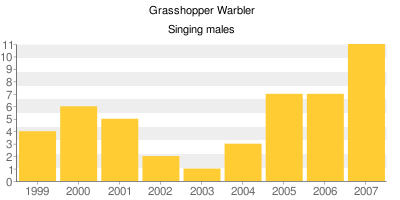
The nest is built on or near the ground in a hollow inside a tussock or other dense vegetation.
Sedge Warbler
This has always been a common species at Netherfield and suggests their territories must be quite small to fit so many in such a small site. Their erratic song is a part of the summer sound of the lagoons. Like the Grasshopper Warbler they like brambles and scrub, but those chosen often border reeds or water. After the main arrival in spring there seems to be chattering song coming from almost every bush. There is also a dip in the Sedge Warbler’s numbers but this one occurred in 2005, when there was a drought in the Sahel, their wintering ground in Africa. Numbers now seem to be picking up and also suggest an upward trend.
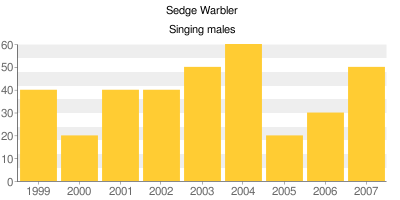
They like to build their nests in a wide variety of situations, sometimes suspended over water from several vertical stalks and sometimes on the ground under thick vegetation. Some nest well away from water and have recently started to use crops such as oil seed rape to build their nests in.
Reed Warbler
This species is almost completely dependent on the reed beds for breeding sites and, as the reed beds spread over the slurry and around the other pits, so their numbers increase. The first counts were in the region of fifteen birds but now counts are nearer twenty-five and their rhythmical songs fill the air as you walk around the Slurry Lagoon.
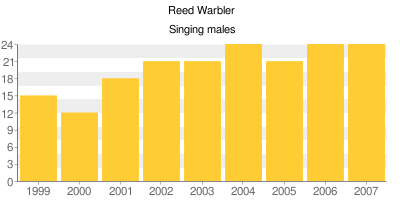
By far the commonest nest site is in a reed bed, suspended over the water by several reed stems. Even the small patches of reed in the deep pit can hold a breeding pair.
Blackcap
The preferred habitat for the Blackcap includes some mature trees and tall scrub, most of which can be found around the periphery of the site. There has been an increase in young ash trees growing around the site and some of the hawthorn scrub is quite tall, which seems to suit this warbler well. The male’s song is loud and richly musical and is generally given from the taller trees in its territory.
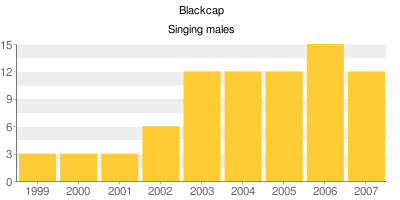
Blackcaps prefer to nest slightly higher off the ground than other warblers and may nest in a bush or on the low branch of a tree, up to eight feet from the ground.
Garden Warbler
As the tall, dense scrub on the slopes of the Deep and Slurry Pits develops, so does the favoured habitat of this species. When small gaps were made within these areas of scrub the Garden Warbler quickly moved in, showing this could be the way to increase their numbers further. The song is not as ‘fluty’ as the Blackcaps and is more ‘scratchy’ and sustained in its delivery.
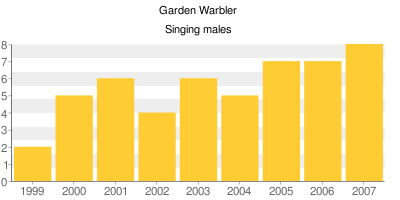
Nests are normally situated closer to the ground than the Blackcap’s, typically about a foot up in dense scrub, wedged in between supporting stems or twigs.
Lesser Whitethroat
In 1999 there were only about two pairs in the area, but now there are more birds seen each spring and there are probably nearer to four pairs, with up to eight males passing through on passage. The habitat that tempts them to stay and breed is generally where brambles grow high up against a hedge or bush and the stems hang down from the top. The pair can spend the summer in there and, without the male’s rattled song; the world could be oblivious to them.
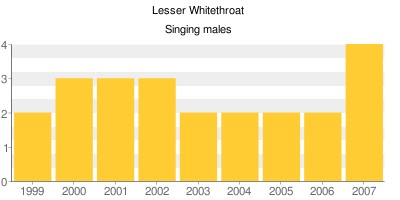
They prefer to build their nests in dense dark cover, normally a couple of feet above the ground, the dense bramble patches making an ideal site.
Whitethroat
This is another warbler that is present in large numbers on the reserve and numbers have risen as the scrubby habitat they prefer has developed. They normally make their territories where they can find bushes for song posts that are about three metres high, surrounded by nettles and hemlock or cow parsley or other rank vegetation where they can hunt for insects. They often launch themselves into the air as they deliver their song.
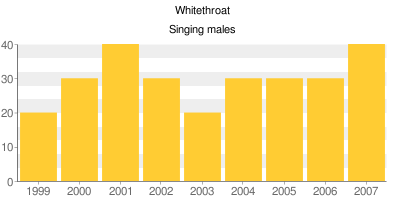
Normally the nest is built quite close to the ground in dense vegetation, but is sometimes higher in thick bushes.
Chiffchaff
The Chiffchaff prefers woodland with mature trees so we are quite lucky to have some on site. Their two-note song is sometimes performed from the power lines along the railway embankment. They are mainly along the railway line, riverbank and Boundary Hedge where the tallest trees grow, with a dense shrubby under-story. They are showing signs of increasing but two glitches, in 2002 and 2006, also show that they are still vulnerable to setbacks.
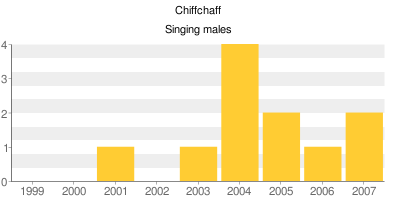
The Chiffchaff builds its domed nest close to or on the ground in rank vegetation or on a low branch, concealed by leaves.
Willow Warbler
This is another species that prefers scrub, but broken by some taller trees as well. Nationally the species is in decline but the site again manages to buck the trend and the gently descending notes of the song can be heard around most of the reserve.
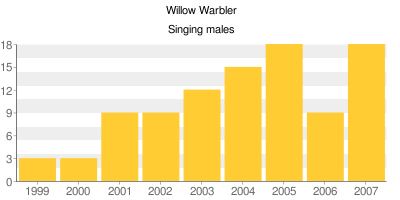
The nest is normally built on the ground or very close to it in thick cover of stems and leaves, and is domed, like the Chiffchaff’s, with an entrance towards the side.
As most of the warbler species nest on, or close to, the ground they are vulnerable to disturbance, especially by dogs, and the fences erected around the Slurry Lagoon and Deep Pit are probably also part of the reason for their recent success.
The downside to the increasing numbers of warblers is that the habitat that has developed and is encouraging them is replacing the bare muddy expanse that used to attract waders. There are just as many species of wader being recorded, as they follow the course of the river Trent and fly over the site, but not so many stop over and those noted are more likely to be individuals rather than the small groups that used to stop to feed and rest. The changes that seven years of colonisation by reeds, scrub and trees have made can be seen in the photographs reproduced as plates vii and viii. Unfortunately they were not all taken at the same time of year, but they do make the point.
References
Colin Harrison – A Field Guide to the Eggs, Nests and Nestlings of British and European Birds – Collins – 1975
Eric Simms – British Warblers – Collins / New Naturalist – 1985








